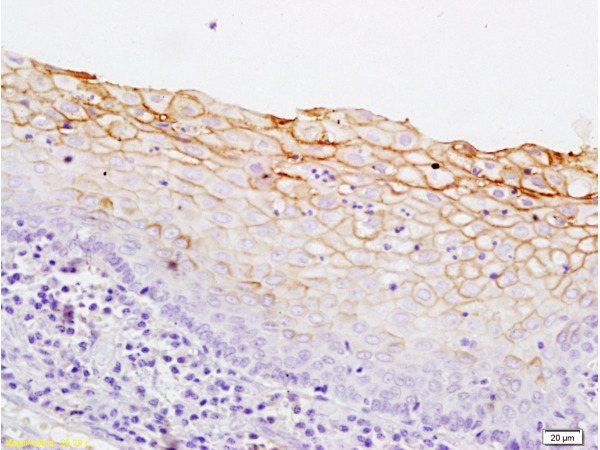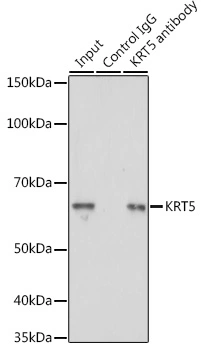Cytokeratin 5 + 14 antibody
GTX40203
Overview
- SupplierGeneTex
- Product NameCytokeratin 5 + 14 antibody [LH8]
- Delivery Days Customer9
- Application Supplier NoteIHC: Use at an assay dependent dilution. Optimal dilutions/concentrations should be determined by the end user.
- ApplicationsImmunoHistoChemistry
- CertificationResearch Use Only
- ClonalityMonoclonal
- Concentration0.8 mg/ml
- ConjugateUnconjugated
- Gene ID3852
- Target nameKRT5
- Target descriptionkeratin 5
- Target synonyms58 kda cytokeratin; CK5; CK-5; cytokeratin-5; DDD; DDD1; EBS2; epidermolysis bullosa simplex 2 Dowling-Meara/Kobner/Weber-Cockayne types; K5; keratin 5 (epidermolysis bullosa simplex, Dowling-Meara/Kobner/Weber-Cockayne types); keratin 5, type II; keratin, type II cytoskeletal 5; KRT5A; type-II keratin Kb5
- HostMouse
- IsotypeIgM
- Scientific DescriptionCytokeratins (CK) are intermediate filaments of epithelial cells, both in keratinizing tissue (ie., skin) and non-keratinizing cells (ie., mesothelial cells). Although not a traditional marker for endothelial cells, cytokeratins have also been found in some microvascular endothelial cells. Atleast 20 different cytokeratins (CK) in the molecular range of 40-70 kDa and isoelectric points of 5-8.5 can be identified using two dimensional gel electrophoresis.Biochemically, most members of the CK family fall into one of two classes, type I (acidic polypeptides) and type II (basic polypeptides). At least one member of the acidic family and one member of the basic family is expressed in all epithelial cells.Monoclonal antibodies to cytokeratin proteins can be useful markers for tumor identification and classification. Belonging to the type A (acidic) subfamily of low molecular weight keratins and existing in combination with keratin 5, keratin 14 distinguishes stratified epithelial cells from simple epithelial cells and is useful in identification of squamous cell carcinomas. It is considered a prognostic marker in breast carcinomas.
- Storage Instruction-20°C or -80°C,2°C to 8°C
- UNSPSC12352203



![IHC-P analysis of human skin tissue using GTX83080 Cytokeratin 5 antibody [3E2F1].](https://www.genetex.com/upload/website/prouct_img/normal/GTX83080/GTX83080_20170912_IHC-P_1_w_23061322_907.webp)
![WB analysis of HeLa cell lysate using GTX83135 Cytokeratin 5 antibody [1E1].](https://www.genetex.com/upload/website/prouct_img/normal/GTX83135/GTX83135_20170912_WB_w_23061322_928.webp)
![IHC-P analysis of human skin tissue using GTX17130 Cytokeratin 5 antibody [XM26].](https://www.genetex.com/upload/website/prouct_img/normal/GTX17130/GTX17130_20191203_IHC-P_24_w_23060620_298.webp)
![IHC-P analysis of human prostate tissue using GTX22535 Cytokeratin 5 + 18 antibody [C-50].](https://www.genetex.com/upload/website/prouct_img/normal/GTX22535/GTX22535_20191028_IHC-P_1_w_23060620_451.webp)

![IHC-P analysis of human lung squamous cell carcinoma tissue using GTX33612 Cytokeratin 5 antibody [RM226]. Dilution : 1:200](https://www.genetex.com/upload/website/prouct_img/normal/GTX33612/GTX33612_20200909_IHC-P_225_w_23060800_662.webp)